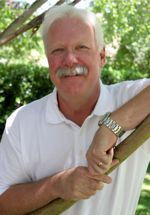
Having experienced a near death experience of Sudden Cardiac Arrest (SCA) has significantly changed my life. The description of my survival is based upon my wife’s recollection since I was suddenly stricken with SCA at a professional friend’s home in Rocklin, California seven years ago. I do not remember anything that happened when I suffered the SCA, nor do I remember the week prior to my SCA.
We had just arrived at a professional friend’s house at 2 pm on August 9, 2008. It was a 1.5 hour drive to their home, where we were attending a memorial dinner for our friend’s husband who had passed away three weeks prior. I was speaking to a couple of friends and a local track coach who coached my friend’s daughter, when I collapsed suddenly, was unconscious and not breathing. The track coach immediately recognized that I was not breathing and he started CPR and someone activated the 911 system. The paramedics arrived within 5-6 minutes and I was shocked four times to re-establish cardiac rhythm. I was transported to Roseville Sutter Medical Center ER. In the ER, I went into SCA again and was shocked four more times. Tests revealed that I did not suffer a heart attack, or myocardial infarction. I underwent angiography, which revealed that my coronary arteries were very clear for a 56-year-old man, thus my problem (SCA) was related to an electrical problem or cardiac arrhythmia.
I was transferred to ICU where I underwent hypothermia. Three days later, I came out of a coma and began to recognize my family and a couple of very close friends who were with my wife and two daughters while my body was fighting for survival. I left the hospital 10 days later with an ICD (implantable cardioverter defibrillator) implanted in my chest and my cognition was normal. Pneumonia contracted in the hospital slowed my recovery, however, two months after my SCA I returned to work as a physical therapist at the private practice that my wife and I own. In addition, at this point in the post SCA recovery, I was walking four to five miles a day, which I continue to do as an important component of my recovery.
The change in my life also stems from the fact that on August 23, 2007, a year prior to my SCA, I saved a man’s life with CPR on a golf course in Incline Village, Nevada. This was a very humbling event since when I came upon the victim he was not breathing, his skin color was blue/black and a man was attempting CPR. I took charge of the scene, a fellow golfer activated the 911 system and I started CPR. It seemed like it took forever for the paramedics to arrive. The paramedics shocked the victim five times to re-establish his cardiac rhythm. He was then transferred via helicopter with good vital signs to a hospital in Reno, NV. This gentleman survived and to this day, we are very close friends. So, saving someone’s life with CPR, then surviving a SCA a year later dramatically changes one’s perspective on life.
I remember saying to my golf buddies after saving the man’s life that you better hope and pray if you ever go down with a heart issue that you are around someone who knows CPR, because early intervention with CPR will give you about a 50%-80% chance of survival. My good fortune of being in the presence of many colleagues (physical therapists) and friends who knew CPR saved my life. These mutually related experiences (e.g., saving a man’s life with CPR; then being saved by CPR) made me think that I have to give back to society for my good fortune of surviving a SCA.
My wife Edie and I became involved with the San Ramon Valley Fire Districts (SRVFD) Heart Safe Committee (HSC), which has been responsible for putting AEDs in every school in our district and in every police car. We have stimulated our HSC to initiate hypothermia programs in our six local hospitals and currently all paramedics within the SRVFD institute hypothermia in the ambulance for SCA victims. In addition, my wife and I became American Heart Association (AHA) CPR/AED instructors. We have volunteered many hours to teach citizens CPR/AED within our county. Our HSC team has trained more than 12,000 citizens in hands-only CPR and how to use an AED over the past 3.5 years. The survival rate from witnessed SCA in our Valley in 2013 was 32%; in 2014 our witnessed SCA survival rate rose to 80%! So our training program significantly affected our local survival rate. The past three years our HSC has been teaching hand-only CPR and use of an AED to all 7th graders (3,000 students/year) in the San Ramon Valley School district. I have lobbied for mandatory CPR/AED training for all high school coaches and to have AEDs at every high school sporting event. While this has not yet been successful, it will be.
In sum, my survival has provided the stimulus to become a trained CPR/AED instructor, serve on the AHA 2020 Task Force, co-chair of AHA 2020 Task Force CPR committee, serve as a Board Member of PulsePoint Foundation and to volunteer within the SRVFD to help save lives and educate the public about important live saving techniques such as CPR/AED use and “heart” healthy living. Every day is a great day for me, since I am very fortunate to be on this planet. I am thankful also for my wife, children, friends, the paramedics and my rescuer who never gave up on me during the immediate hours of my SCA seven years ago. I have been told that my “never give up attitude” probably contributed to my survival.
Submitted by Joe Farrell
